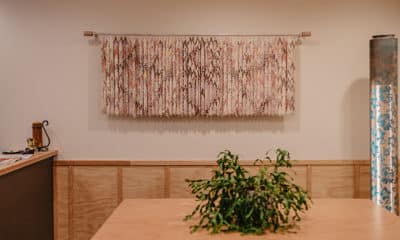SINCE THE ONSET OF the COVID-19 pandemic, I’ve been consistently impressed by the print industry’s ingenuity and willingness to help. We’ve been confronted with an unprecedented challenge, and many of us have had to reimagine our entire business model and shift to something new. A few months ago, PPE was a foreign acronym, but now it’s driving many of our shops and helping keep our doors open. Whether you’ve already made the transition to PPE production or have been considering making the jump, the demand is here and it’s time to innovate.
If you’re new to producing PPE face masks, one of the first questions you’ll undoubtedly ask is, “what fabric should I use?” There’s been a healthy worldwide discussion on this topic over the course of the past few months, and the truth is there isn’t just one fabric that works to successfully create effective PPE. A multitude of factors contribute to the fabric’s performance as a face mask, and it’s imperative to understand the different variables before your operation gets underway.
Synthetic Fibers vs. Natural Fibers
I’ve spoken to a fair share of PSPs over the past few months and the conversations generally focus on whether synthetic or natural fibers create a better face mask. For most shops, printing capabilities will dictate which type of fiber will be utilized. If you’re running dye sublimation, latex, or direct disperse printers, you’ll source polyester. If you’re running a digital pigment printer, you’ll likely source cotton or another natural fiber. However, if you’re fortunate enough to run both synthetic and natural substrates, you’ll find yourself in the middle of the debate.
For reference, heavily regulated, medical grade N95 respirator face masks and surgical face masks are made from synthetic, non-woven materials. If you’re using medical face masks as your guiding light and want to produce something close in resemblance, polyester will be the way to go. Additionally, it’s important to note that synthetic fibers typically have increased durability and thus a longer lifetime. If you’re trying to offer an alternative solution to those who do not want to have synthetic fibers touching their skin (for allergenic reasons or personal preference), natural fibers will be the right choice. Both synthetic and natural face masks can act as a protective physical barrier between the wearer and contaminants, but fiber content alone does not make a face mask effective. Fabric constructions and finishes are vital components, as well.
Fabric Construction
Fabric construction – rather than content – is the most critical factor when producing a face mask. If the knit or weave isn’t tight, particles can easily move through the fabric, thus making the face mask ineffective. Using fabric with a higher number of yarns per square inch is key. The fundamental objective should always be to produce a face mask that can block large-particle droplets, splashes, splatter, and sprays. It’s crucial to prioritize fabric construction in your conversation with your fabric supplier when sourcing fabrics for face masks. A loose knit or weave won’t get the job done, will only act as a symbolic barrier, and will give the wearer a false sense of safety.
Utilizing a fabric constructed with stretch is also a way to increase function and comfort. Stretch – whether created with spandex or built in mechanically – helps the masks fit snug across the wearer’s face. Additionally, it helps prevent particles from escaping through the sides of the face mask as it will fit closer against the skin. Preventing malfunction is paramount and using a stretch fabric allows for better fit and performance.
Advertisement
Fabric Finishes
There are several ways to increase performance and build layers of protection in PPE design. One of the best ways to do this is by using a fabric with a specialized finish. There are several finishes that will elevate face mask performance, but in the case of PPE, nothing rivals an antimicrobial finish. A fabric with this type of finish terminates the growth of microorganisms, which include viruses and bacteria. Antimicrobial finishes have been applied to fabrics in the medical industry, from hospital gowns to curtains, for years. It’s even regularly applied to activewear fabrics to combat germs produced when the wearer sweats.
Antimicrobial finishes are applied to fabric at mill stage; it’s not something that can be added later in the production process. It can be applied to both synthetic and natural fibers, but the process of application differs. Adding an antimicrobial finish to synthetic fibers requires a process using heat and exhaust, while a process using padding technology successfully applies the finish to natural fibers.
As we continue to monitor the spread of COVID-19 in our country, it’s becoming increasingly clear that one of our most significant challenges is to simply get people accustomed to wearing face masks. We must adapt to form this new habit. I believe we can help advance this effort by increasing the physical comfort of PPE. Making a breathable fabric is an immediate way to do this, especially in warmer seasons and climates.
I wrote about breathable finishes in my last column, “The Power of Polyester,” and noted there are numerous names used to describe the same type of technology. To recap, I’m talking about wicking or moisture management finishes. Though it may seem counterintuitive at first, breathable finishes can simultaneously act as a particle barrier and wick moisture. To better illustrate this concept, think of the opposite: a face mask that absorbs moisture (sweat, coughs, sneezes, etc.) and clings to your face as you go about your day. That face mask will only continue to absorb particulates and its effectiveness will decrease the longer you wear it. A face mask with a wicking finish will aid in moisture evaporation and keep the wearer dry and comfortable.
Breathable wicking finishes can be applied to both synthetic and natural fibers at mill stage, although it’s more frequently applied to synthetic fibers because natural fibers innately breathe. Over the last few years it has become more common to apply wicking finishes to natural fibers to increase performance. I encourage you to consider sourcing breathable fabric because, after all, increased comfort will lead to increased use.
It’s important to note that fabric with a breathable finish should not be washed with fabric softener because it will block the pores of the wicking agent. Be sure to communicate these wash instructions to the wearer as it will inform the finish’s longevity. As a general rule, I suggest all face masks be air dried because heat reduces the fabric’s life span.
Advertisement
Adding a UPF sun protective finish to PPE is another way to increase layers of protection. UPF finishes are rated from 15 to 50+; the larger number corresponds with a lower percent of UV ray transmissions. UPF finishes have gained popularity in the apparel industry over the past few years and will certainly give face masks an edge, especially for those who work outdoors.
Understanding the Variables
When health and safety are on the line, understanding the nuances of fabric content, construction, and finishes is imperative. Each element is an integral part of the finished product and even impacts pattern development and sewing processes. Shifting to PPE production means we can’t source fabric solely based on print clarity and color vibrancy. There’s a lot more to consider because there’s a lot more at stake.
Whether you produce laser cut face masks that require little sewing, gaiter-style face masks, accordion-style face masks, or face masks with a filter insert, be sure to source a fabric that addresses the needs and complexities of your face mask design. The good news is the fabric suppliers to the digital print industry have been doing their homework and can help evaluate your product and answer the tough questions. The leading fabric suppliers in our industry are even launching specialized fabrics for PPE that not only meet CDC recommendations, but are optimized for digital printing.
Right now, the idea that “necessity is the mother of invention” couldn’t be truer. By flexing both our technological and creative muscle, we can respond to the urgent pressures we face today. Producing PPE may be the viable route to keep your shop open now, but it could also become a mainstay as a core part of your business. Who’s to say what will happen next? All I know is the print industry will be quick to respond to whatever comes our way.
Disclaimer
Information on the topic of PPE is evolving daily. Please refer to the CDC for health and safety guidelines in regard to PPE and the COVID-19 pandemic. Insights expressed in this article are based on government recommendations and thorough, personal research.

 Best of Wide Format2 months ago
Best of Wide Format2 months ago
 Best of Wide Format2 months ago
Best of Wide Format2 months ago
 Blue Print3 weeks ago
Blue Print3 weeks ago
 Best of Wide Format2 months ago
Best of Wide Format2 months ago
 Best of Wide Format2 months ago
Best of Wide Format2 months ago
 Best of Wide Format2 months ago
Best of Wide Format2 months ago
 Best of Wide Format2 months ago
Best of Wide Format2 months ago
 Best of Wide Format2 months ago
Best of Wide Format2 months ago





















